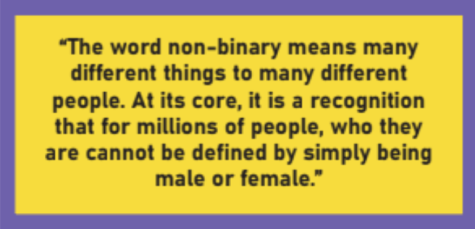Presentation and Expression
May 27, 2022
In today’s society, many feel pressured to present themselves as either female or male. For those who identify as non-binary, the idea of finding a way to present their gender to others can be a daunting task.
Oftentimes, presentation of gender centers around how others perceive a person, which may not correlate with how they feel on the inside. Traditionally, there are certain characteristics that have been widely perceived as masculine or feminine: masculine muscular builds, feminine long hairstyles, and more.
However, as explained by Porter, “there is no [one] way to look non-binary.” Non-binary people express themselves in all kinds of different ways, and may want to appear conventionally feminine, masculine, or somewhere in between.

“To me it’s very important to understand how I want to present for the day, because if I don’t present in the way that I feel on the inside, it makes me feel anxious and uncomfortable. It just feels like you’re in the wrong body,” said Hawkins.
One of the ways people, including those who identify as non-binary, can express their gender is through how they dress. That can change from day to day, and may even serve as a helpful tool of exploration for those who are still trying to figure out their gender identity.
Hawkins said, “I felt both like a boy and a girl at the same time, and I didn’t know how to express that, [and] it took me going to Goodwill and buying new clothes to figure it out.”
Another method of gender expression can involve physical changes to a person. Some people may choose to change their hair — growing it out, cutting it, or trying a new style — in order to present themselves in alignment with their feelings about gender. Others, especially among non-binary adults, may seek to alter their bodies, taking hormone treatments or getting gender-confirming surgeries, such as top surgery. For younger individuals, puberty blockers can be a treatment option that make no permanent body changes, but delay the onset of natural body developments that may contrast with one’s desired presentation.
Advocates emphasize that identity and expression/presentation are not the same thing. While they are, of course, directly related and often aligned, some people may not be comfortable expressing themselves in a way that matches how they feel in terms of their identity.